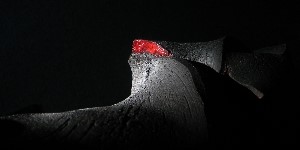Process
Making and firing are analogous to geological processes – indeed are a speeded up subversion of them, drawing parallels with the artist’s lifespan on earth in relation to geological time. The textured surfaces that dominate much of my work are produced using stretching techniques similar to tectonic forces in nature. The firing process that takes clay - a sedimentary rock – and turns it into ceramics – a metamorphic rock- is an exact analogue to the way in which metamorphic rocks are formed in nature by volcanic action heating clays. Firing is seen as a part of the process, not as a way of adding a decorative surface. Like metamorphic rock, my work will, eventually, irrespective of the value placed on it (or not) by humans, re-enter the geological cycle, be destroyed and weathered to re-form clay...
Technical details
Conventional throwing is, in essence, an exercise in 3D extrusion where the hands control both the inside & outside of the vessel wall. Much of my textured surfaces are, however, formed by stretching techniques that comprise throwing a ‘kernel’ of the desired form, texturing the outside of the form by faceting, cutting, combing etc, then developing the texture by throwing only from the inside of the pot.


Twisted form (detail). Thrown, faceted & stretched, Earthstone ES20 clay, Raku kiln.
Scarva Earthstone ES20 or Potclays Crank are used for both thrown and manipulated heavily textured pieces or Raku fired work. Potclays Buff Stoneware is used for less textured domestic ware. All work is bisque fired in an electric kiln at 900C, then glaze fired to 1260C or Raku fired in a propane kiln to around 900C. Stoneware glazes are based around classic stoneware reduction glazes, modified for firing at slightly lower temperatures (typically 1260C rather than 1300C) in an oxidizing rather than reducing environment. These glazes use basic naturally occurring materials – quartz, feldspar, kaolin, iron oxide etc. Depth and optical effects in the resulting surface are the result of multiple layers of glaze, control over the glaze thickness and time at high temperature in order for convection and flow effects to become apparent. Raku glazes are frit based, allowing low melting points whilst avoiding traditional lead-based formulations.
Lines of Investigation
My interest in surface texture inevitably lead to experiments with wood firing. This work is on-going, but since moving to the North Norfolk coast in 2014 I have been investigating the use of local materials in glazing together with the relationship between form, function and decoration with the aim of producing work that challenges perceptions of what is a useable pot, and that relates to the local landscape. The reed banks found on coastal salt marshes, particularly in the Cley area, are a distinctive part of the local landscape, on which I draw for both colour and texture. Still used for thatching, the reed has a high silica content, and forms the major component of my glazes. Texture, and the contrast between a textured exterior and a more conventional interior, are an important aspect of my work. Everything I make is intended for use - further, it is intended to be appreciated through use, and to give on-going tactile and visual interest.
Much of this work involves the use of ash derived from thatching reeds, and the mud they typically grow in. The ash is used in sagger firing to produce surface texture, and the mud as a direct glaze ingredient.

